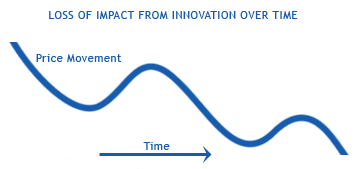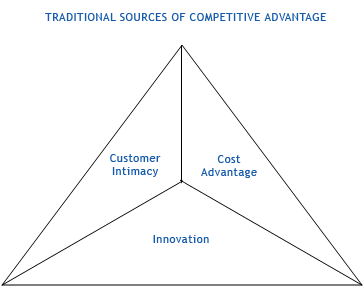
What’s wrong with driving your business using the historic S-curve (innovation) model? The innovation model has virtually dominated all literature, organization design, sales training, and investment strategies since the world economic boom following World War II. This is the common and erroneous management belief that we can continue to grow our business by improving current products and/or continuously making breakthrough innovations.
We call it the Drug of Innovation.
Many of the great B-to-B brands that appeared during the last century were created riding a breakthrough innovation – copiers, computers, etc. The ability of these companies to differentiate their brand through their products and drive significant margins- as their products were first adopted by the market then improved for the markets – was a very long cycle.
To understand how much that’s changed and will continue to change look at the PC life cycle – introduced by Apple, then quickly dominated by IBM – then a free for all with many entering, exiting and dominating (rags to riches to rags) changing all the time. Today leadership oscillates between a few players with cost becoming the driving factor, as important, if not more important than product innovation.
For the few firms that ride a breakthrough technology to market, the innovation model should be the dominant business model and can be effective for a time. But for many established companies particularly in North America and Europe, the ability to differentiate a product or product line through feature enhancement has a very limited life cycle that is being ruthlessly compressed as more global product players come on-line particularly from China and India. Furthermore, unless you happen to be Steve Jobs, the ability to predict breakthrough technologies that create whole new markets is virtually impossible.
We find the diagram below almost always describes a company’s experience with innovation.

As we all know price differential begins to be pressured after a time for new products or product enhancements. The issue for most firms is that this compression of price differential comes ever more quickly. Soon firms and often entire industries are trapped in a no-win game of musical chairs as they take turns leading with ever-fleeting advantages based on product innovation. Not only does commoditization rapidly effect their valuations but the musical chairs inevitably causes firms to innovate past their customers’ real needs – thereby sinking hundreds of millions into products that few need at any price.
Question: When should firms get off this Drug of Innovation?
I believe the first step for most companies is for someone (sometimes anyone) to accept that the musical chairs cycle of innovation will slowly strangle the business. This is so important – someone must see clearly that the emperor has no clothes. Then they must accomplish a couple of things:
- Gain an understanding what the business model options are, what the correct direction is and become familiar with journey,
- Build a community within the business coalescing around these truths.
This in itself is very difficult – as I mentioned before, the innovation model dominates our business culture – we are prisoners of our mindsets.

We believe that an understanding of the business model choices immediately helps a business see its few options. Historically there have been three distinct business models that have been successful – Innovation, Low cost, and Intimacy.
That is not to say that each component is not pursued but that the business model used is driven primarily by one of these components.
Let’s define customer intimacy as a business model: organizing business efforts to identify ideas to address true customer problems/opportunities at the highest level, bring those to the customers, and living with them to take advantage of those ideas.
It is a complete integrated model – not a sales program. At best, customers see you as an extension of themselves.
This blog is dedicated to the importance of this topic and the how of getting there -and there is much how. But let’s, for a moment, take one aspect of it for illustrative purposes.
If we are going to be preoccupied with identifying/creating ideas that fundamentally help our clients (and lets call them clients – customers buy things, we serve the best interest of clients) then more of our R&D spend must be about those ideas. Let me give an example: let’s say you provide some complex equipment for hospitals. Some R&D spend must be on the broader Hospital problems – how to lower error rates in the hospital, how to get patients through faster. You must bring better ideas to the client then the consulting firms they deal with today. I know this seems impossible and it’s not clear how it helps sell your current products – I assure you it’s not impossible (in fact it’s relatively straightforward) and it fundamentally impacts sales of current products.
